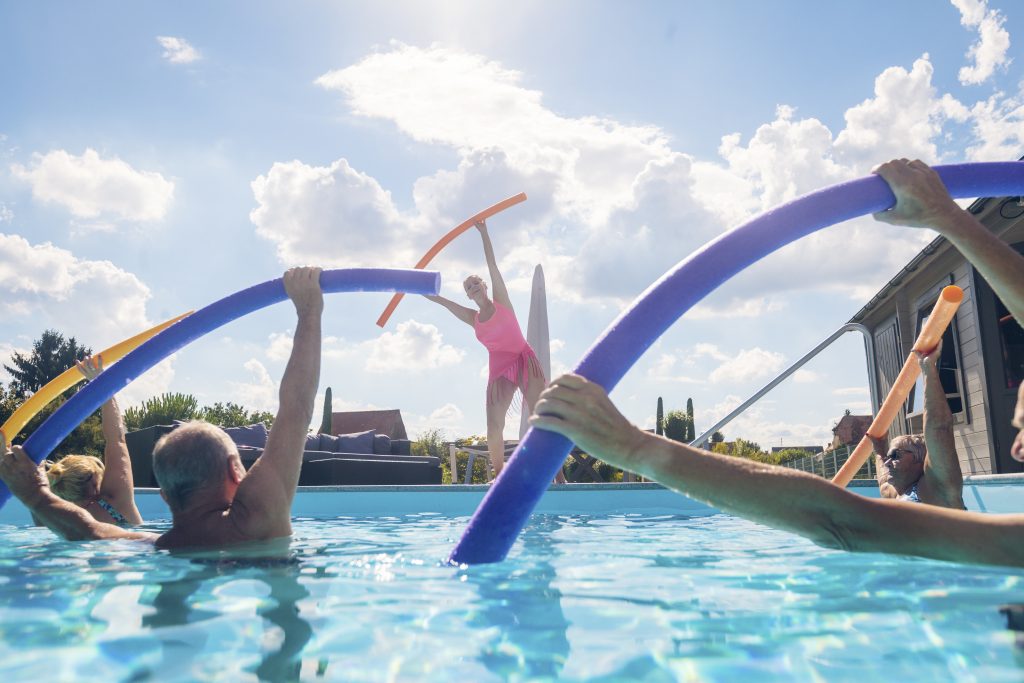If your knees hurt when climbing stairs or the joints in your hands and elbows hurt when gardening, many sufferers try to take it easy and avoid moving their joints as much as possible. However, this supposed precautionary measure is a fallacy – coordinated movement usually provides relief. Here you can read why gentle exercise is good for your knees and elbows and which sports are particularly recommended.
Why is joint-friendly sport the right approach?
In cases of pain, discomfort and illness, doctors often advise patients to take it easy until they feel better. In the case of painful joints, however, this is not always the right approach: too little movement ensures that the cartilage layer within the joints is no longer sufficiently “lubricated”. The cartilage becomes inelastic and brittle. If the joints are now subjected to excessive strain, cartilage abrasion occurs which maintains a state of irritation. This causes the often complained of pain.
Once the cells of the cartilage are damaged, they cannot be regenerated. However, osteoarthritis, i.e. the wear and tear of cartilage, can be counteracted by regular and gentle exercise. The right amount of exercise is important here, as is ensuring that the cartilage is supplied with essential nutrients. Finally, they can be relieved by strengthening the muscles that stabilize the joint. This also ensures that pain can be alleviated in the long term.
What do you need to look out for in sports that are easy on the joints?
Pain in joints is not always caused by wear and tear of the cartilage or even osteoarthritis. Instead, it can be caused by various factors such as injury, overloading or various illnesses. For this reason, the cause of the pain should be diagnosed by a doctor before starting any sporting activity. A doctor or physiotherapist can also help you choose the right type of sport and determine the extent to which it should be practiced.
Sports that put strain on the joints through rapid and forceful impact should be avoided. This includes, for example, sports such as soccer or tennis. Instead, activities that involve rhythmic, even and constant movements are recommended.
Training should always begin with a warm-up. Ideally, this should include stretching and mobility exercises to get the circulation going and stimulate blood flow. This ensures that the joints and muscles become supple and the body is prepared for the exertion. This minimizes the risk of injury during sport.
If the body has been properly warmed up before exercise, there should be no pain during exercise. If this does happen, it is advisable to take a break or stop training for the time being. Otherwise, overloading and injuries can occur. For beginners, it is advisable to take your new-found hobby slowly and to focus on constant muscle stimulation rather than a one-off overload.
Which sport is easy on the joints?
Water gymnastics, aqua jogging and co.
In water gymnastics and aqua jogging, the movement sequences are performed in water. Due to the pressure and natural resistance of the water, some strength is required, which in turn trains coordination and endurance. The buoyancy of the water also ensures that there is minimal strain on the joints. The sport, which takes place in swimming pools and wellness centers, is therefore particularly suitable for older athletes, but also for anyone who wants to do something good for their health without putting unnecessary strain on their joints. The wide range of activities on offer includes not only gymnastics, but also aerobics, aqua dancing, aqua boxing and aqua Zumba. If you prefer to train independently of a group and at your own pace without having to give up a water sport, swimming is the perfect option.

Swimming
Swimming offers an easy to challenging full-body workout that puts virtually no strain on the joints. This sport is therefore suitable for any age or fitness group, especially if you want to lose excess weight. It is important to perform the movements in a controlled manner so as not to put unnecessary strain on the knees and cervical spine. A trainer can help you learn or improve your technique. When done correctly, swimming is a good cardiovascular workout that strengthens the muscles and burns a lot of calories.

Hiking
While jogging puts a lot of strain on the joints, hiking has several advantages: The leisurely but steady sport strengthens the muscles of the thighs and in this way relieves the strain on the hips and knees. The steady movements should be carried out with good hiking boots and as little luggage as possible in order to save unnecessary weight. A moderate walking pace on routes with soft ground, for example in the forest, is easy on the cartilage in the joints and strengthens the heart. At the same time, conversations with sports partners remain possible. If you want to walk uphill, you should use walking poles, as these significantly reduce the otherwise higher strain on the spine and knees.
Nordic Walking
Nordic walking is also based on this principle: the use of poles relieves pressure on the knees, ankles and spine. The athlete does not carry their body weight exclusively on their legs, but also supports it with their arms, which are strengthened as a result. The muscle groups in the shoulders and chest are also used. This burns more energy than walking or hiking, for example, which is why Nordic walking is an effective and demanding sport. Here too, attention should be paid to soft ground, for example forest floors.
Rowing
Rowing uses around 80% of the body’s muscle groups – regardless of whether the sport is performed in the water or on the corresponding sports equipment in the gym. At the same time, the flowing movements are easy on the joints. The cardiovascular system is strengthened and endurance is improved, making the body more efficient with regular training. The strengthened muscles absorb future stress on the joints and compensate for it. Finally, rowing burns more calories than many other endurance sports, which is why it is often used to reduce body weight in the long term.

Cross trainer
If you used to go jogging regularly and are now looking for a similar alternative, you should give the elliptical or cross trainer a try. You can find this fitness equipment in all standard fitness studios – but it is also available for training at home. The machine reduces the load on your knees from your own body weight and distributes some of it to your arms. In addition, the unpleasant impact of jogging on the road is replaced by gentle elliptical movements. These are performed in a controlled and even manner, with the knees remaining bent.

Cycling
Another sport that can be practiced from the comfort of your fitness equipment at home is cycling. The gentle pedal stroke promotes the well-being of knee joints and hips and also clears your head in the fresh air. The cyclical movement sequences take place without jolts or high pressure on the joints. In addition, most of the body weight rests on the saddle of the bike, allowing the knees to move freely and without strain. The pedalling speed can be increased or decreased as required, allowing the intensity of the training to be individually adjusted.
Yoga
Yoga and Pilates are sports that have captivated more and more people, especially in recent years. Beginners and advanced practitioners benefit from a gentle to challenging workout that mobilizes the joints and strengthens the muscles thanks to the calm movements. At the beginning, however, yoga should be learned under the supervision of a trainer: They can take individual physical needs into account and help the athlete to choose the right sequences if they are in pain. Advanced practitioners can do the sport flexibly and independently of classes at home or outdoors.